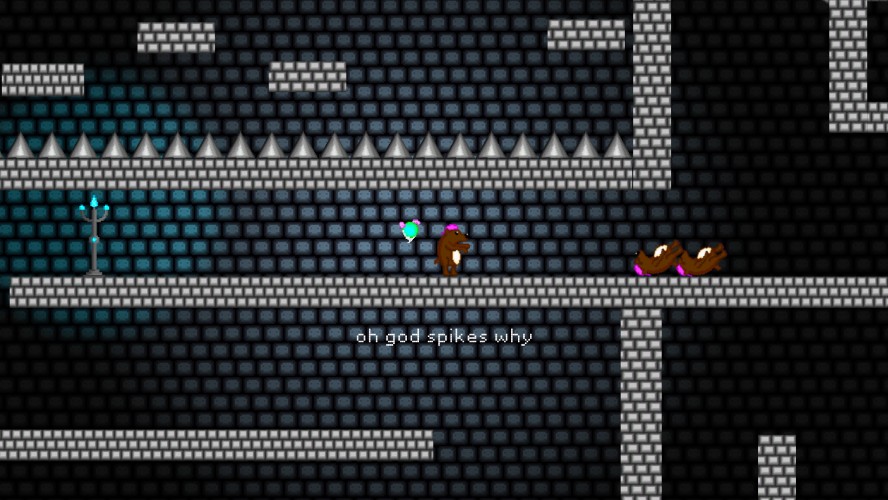So, I just unleashed my heartwarming ursine death simulator onto Steam Greenlight.

A year and a half ago, I entered Ludum Dare 28 with Rude Bear Resurrection, and to my complete astonishment, I won the innovation category. It was a simple idea – whenever you died, you left a corpse behind that anyone else in the world could stand on, and you left a death message people could read.

The jam version was cool, but it wasn’t scalable without having to write an absolute tonne of netcode, and it was really “jam interesting” but the gimmick would wear off. I started thinking about doing procedurally generated worlds, but I didn’t want a project that’d take years.
A few months later, I threw together an acceptable build of the game in 2 weeks for an event. It had to be offline because we had no internet connection – but it went down spectacularly nonetheless. The thing that astonished me was – people were telling me how amazing it felt straight away. It was rough so people understood a lot needed doing, but I was told “Don’t change the engine at all, it’s perfect”, and that it was better than even Meat Boy’s lauded engine. You get a lot of over-the-top compliments at events, though. It definitely still needed some tweaks, but it was a good foundation.

The funny thing was, the physics were coded the same as the jam version – I just added sliders in to determine the optimal values. But the jam version controlled absolutely horrifically badly. I did Physics at uni and specialised throughout my life in Mechanics/Dynamics/Computational Physics, but I never actually stopped to think about how those were exactly what I needed to make a character controller feel perfect.
Well, halfway, the other half was knowing what a controller should feel like, to get the values right. And although I never aspired to make a Meat Boy-like, that game was my life for a couple of months in 2010 – I got 106% game completion. I can’t claim it hadn’t influenced my character controller, but there’s some things I did that I thought were an important foundation:
– Used drag, not friction, everywhere except sliding down walls. This way, the player isn’t encouraged to constantly jump, as walking is the same speed as jumping.


– Used extremely high gravity to counteract the large drag, but have it balanced enough that you reach a comfortable terminal velocity (whereas in my opinion, Meat Boy enables you to accelerate so fast downwards you have to break the flow of gameplay by stopping yourself from moving. To me, the perfect run should be one where you avoid all unnecessary walls).

– Added grace periods after leaving a wall where you can jump in midair for a split second, instead of sticking you to the wall.

– Making it very easy to vertically ascend, instead of being very horizontally floaty.

– I liked the idea of Meat Boy’s “velocity conversions”, whereby if you pull back in a horizontal jump you can go higher than normal, but I restricted this to sliding up walls, so you can gain really good, fast air. Rude Bear is much better at walljumping and timed hops.

– Forced based movement for nicer start/ending movement.

– Non-parabolic jumping. I’ll talk about jumping in another blog sometimes because that deserves an article on its own, but to me, jumping should feel like your character already knew how long you were going to press the jump button down before you did it. I hate jump arcs that abruptly cut off in mid-air instead of giving a natural curve regardless of how high you jump.

It plays very differently to Meat Boy. Despite loving it at the time, now when I play it I long for the Rude Bear character controller when I see a section I know would’ve been much more 1:1.
Because the character controller is super tight, people always draw the comparison to SMB. That’s fair – it’s one of my favourite games of all time, but I definitely think that the fact that Meat Boy’s engine is pretty tight shouldn’t stop us from trying to make things even tighter.
At my first event, I learned pretty quickly that sections where you had to kill yourself were awful. They were repetitive, pointless gameplay that just extended the play time arbitrarily for no compelling reason. I made the decision to make sure you never had to die.
But I discovered something very cool about my corpse system.
This was a platformer on the same lines of all the other insane masocore platformers you know, but everyone could beat it. I could make level 1 difficult straight off the bat because the corpses allowed people to pass the levels. And I mean everyone, I mean small kids who couldn’t even make the first jump were beating the game.

A problem that I never saw with SMB at the time, was that it is too hard for some players. And at the time I was like, “But who cares, they don’t match the target demographic of the game”. But whenever I talk to people who are enthusiastic about Meat Boy, even people wearing the shirts etc, I find a whole bunch of them never even got past Hell. I don’t think I know anyone else who did Cotton Alley. Now, looking back, I think that’s a fundamental flaw – that someone could enjoy your game and truly want to complete it but be physically incapable.
And that’s when I realised the value of Rude Bear. It’s a game that anyone can win. It doesn’t matter how bad you are at it. And it’s not tedious, it’s the same process as Meat Boy in which you’re just trying to get ahead and you’re respawning extremely close to where you died, but you can actually see your progress. I spent literally hours on single 30 second Meat Boy levels before – and I knew I was getting slightly better, but I wasn’t getting further.

Sometimes I’d even ragequit for the day, knowing that the muscle memory is there but a fresh night’s sleep might bring me to completion the next day.
But is that a good thing – making players who want to play your game have to sleep on it to be able to win?
In SRBR you can physically see yourself get further and further, and stand on your corpses, and you feel you’re making progress. And that makes it ridiculously addictive. It’s a series of super hard but ultimately non-frustrating challenges followed by the great feeling of getting to a new checkpoint. Checkpoints break up the levels, and they end up being 10 minutes long to the average player, rather than having small 20 second levels.
There’s a bigger feel of exploration and figuring stuff out, and there’s a chance to beat stuff through intelligently placing corpses in specific places, sheer willpower, or dexterity.

But I’m so glad I stumbled upon this mechanic. Because I make games that are too hard, and it’s hard to make a perfect difficulty curve – I find it hard to make early levels that anyone can beat without making it feel dumbed down and boring for advanced players. But it doesn’t have to be perfect here, because the game makes its own difficulty curve.

For the advanced player, death is an option. In fact, it’s even disfavoured. The ultimate aim for the hardcore player is to lower your death count on every level to 0. And there’s something more compelling to me about executing a perfect run than beating an arbitrary time limit.
Overall, thinking back, the levels I found most frustrating on SMB were levels in which you had limited lives – I hate punishing the player for dying. To me, dying shouldn’t just be a way to learn, it should allow progress.

It’s a super cool system that levels the playing field for everyone without detracting from the challenge for skilled players. Unfortunately it’s really hard to express in a quick trailer or a few snappy words. This is my best attempt at a trailer so far:
Though it still doesn’t do it justice.
If you’re interested, the Greenlight page is here, and I could really use the votes:
http://steamcommunity.com/sharedfiles/filedetails/?id=458651962
Cheers.
Follow me for more news about SRBR and other things: @AlexRoseGames
SRBR on Facebook: SuperRudeBearResurrection.
